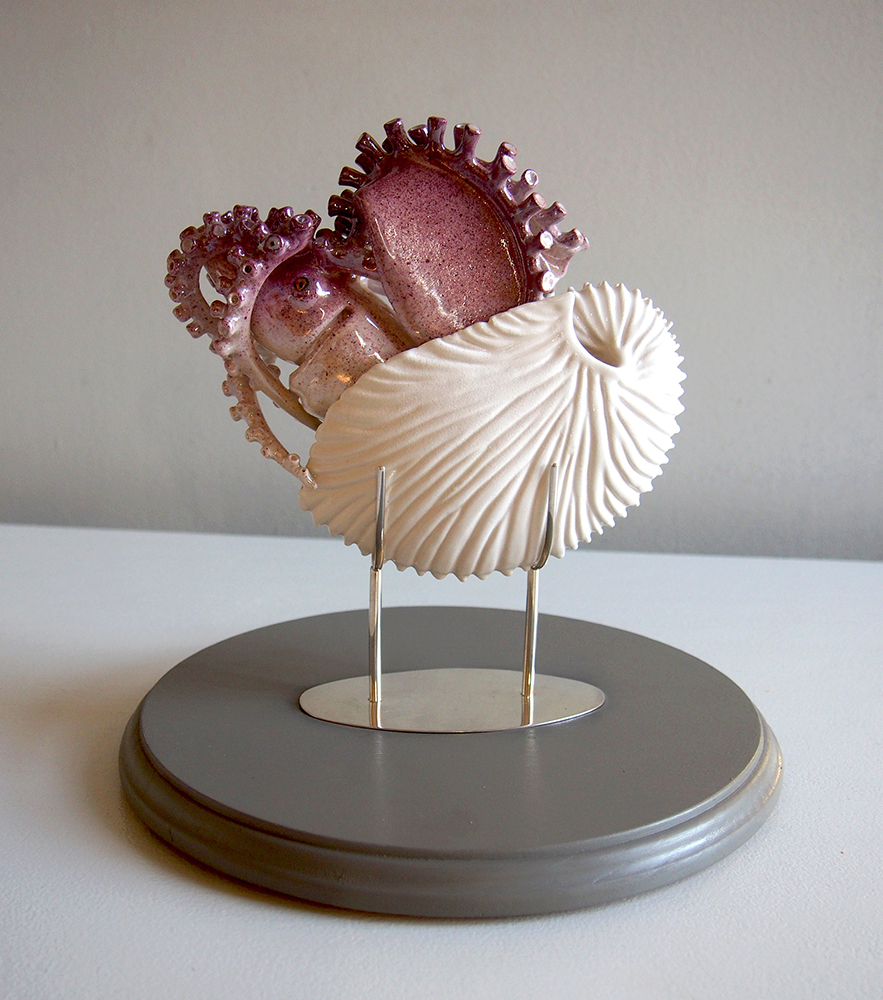
La Mer Jewel Series
Sparked by the gems of the sea, the Jewel Series spotlights Nature’s extraordinary marine design, engineering and color in ceramic sculpture.
A time-sensitive homage and call to honor and care for Earth’s living jewels like life depends on it because it does. Everything is connected.

Argonaut Argo
hand-built ceramic, sterling & wood base, 5.75” x 5.25” x 2.5”
Created for invitational International Cephalopod Exhibit: I Love You More & Science Conference in Crete, Greece. This conference brought together cephalopod organizations for the first time in response to critical climate change effecting the welfare of octopus, cuttlefish and squid.
This rarely seen octupus lives in the open ocean or pelagic zone. They contain chromatophores, enabling them to change color from reflective silver to dark maroon. The Argonaut larvae are color-equipped and change color at birth.
Only the female has an exquisite one-chambered shell which she makes by secreting calcium calcite from two of her technically savvy arms that look like sails. Protecting her and her eggs, the shell also acts as a buoyancy device. She can regulate the air to float at the surface or sink below in the pelagic zone habitat.
They can connect to form chains of 20-30 floating on their sides in the open ocean. The rise in human induced CO2 however, dissolves the security of her shell endangering the already rare little cephalopod.




Diatom Odontella Aurita Spiral Colony
hand-built ceramic, 11.5” x 11” x 7.5”
Created for the international exhibit OCEAN at the New York Hall of Science.
A sculptural play on the exquisite and interdependent microscopic world of this marine diatom species. Their silica or glass lace architecture houses photosynthesizing plankton contributing to our every other breath from the sunlit layer of the ocean. Diatoms form spiral, zig-zag, chain and stellate colonies, fusing together in jewel-like networks to best navigate nutrient rich waters and mutual benefit. Working together diatoms alone provide over 25% of earth's oxygen. Although just one-cell and only visible in a microscope they power up to macro scale with plankton blooms captured on satellite video from space. A stellar model for humanity.



Kemp’s Ridley Sea Turtle Hatchling
hand-built ceramic, 24K gold leaf, 4.75” x 5.5” x 1.5”
This marine turtle, native to the North Atlantic Ocean and Gulf of Mexico is the smallest, rarest and most endangered of all sea turtles and has been critically endangered since 1970. Indigenous to Virginia marine waters this hatchling was made for the solo exhibit La Mer: People Protect What They Love at the Science Museum of Virginia.
The nest processions called arribidas make for high nocturnal drama. The hatchlings have one tooth, caruncle, designed for the sole purpose of breaking through their shell. Once hatched on the same beach its mother and previous generations were born, the hatchling must make its way into the ocean. Those that survive this perilous first trek to the surf must next overcome the journey seaward to live in the pelagic zone or open ocean for 7-12 years until sexually mature. With a stellar internal “GPS” using Earth’s magnetic field, the females swim hundreds of miles back to their birth beach to nest their clutches of eggs. Documentation in 1947 recorded approximately 42,000 females nesting on one beach off the Gulf of Mexico. Today the National Wildlife Federation estimates of 1,000 total breeding females exist worldwide.
The threats are the usual suspects at the hand of humans: fishing gear, pollution, over harvesting eggs and meat, oil spills and climate change. A particularly lethal weapon to the welfare of sea life is the overwhelming amount of plastic now residing in the ocean. Sea turtles mistakenly fill up on plastic debris, which look like jellyfish floating in the ocean. Feeling full with plastic, the turtles actually die of starvation or choke. The volumes of plastic are so immense they have their own migratory patterns now tracked on satellite. The Kemp’s Ridley grows to about 2’ long, 100 pounds and can live 30-50 years if given the chance.


True Lobster, Homarus Americanus: Homage to Michael
hand-built ceramic, 24K gold leaf, 5.5” x 13” x 2.5”
Few know that this large marine crustacean, widely known as a Maine lobster, lives 100 miles off the Virginia coast at the Atlantic shelf. My brother Michael Hagan (1949-1987) a trail blazer, nature lover, sustainable and conscious fisherman did. He was one of the first to lobster off the coast of Virginia. The twinkling gold tooth is a wink to his indelible humor and pioneering spirit.
This lobster inhabits the eastern coast of North America between Nova Scotia and North Carolina, living in crevices and burrows on the sea floor. When feeding, the crusher claw catches prey and its sharper claw dissects it. Averaging 10”- 20” in length, lobsters live approximately 50 years in the wild.


